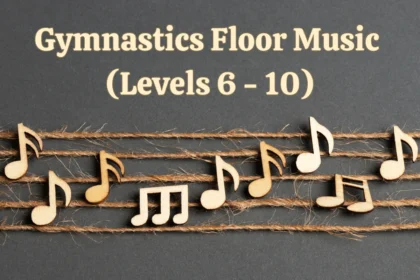Levels exist to make the learning curve humane. They break the sport into manageable steps, ensuring gymnasts master foundational skills before advancing to riskier elements.
For coaches, levels provide a logical roadmap for what to teach next. For judges, they offer a standardized scale that works from preschool rec classes all the way to Olympic finals.
USA Gymnastics (USAG) — The Development Program Ladder
The Development Program, formerly known as the Junior Olympic (JO) Program, is the most widely used competitive pathway in American artistic gymnastics. It’s divided into three major stages—Developmental, Compulsory, and Optional—with an elite tier for top athletes. Alongside it runs the Xcel Program, a more flexible, inclusive alternative.
🟢 Developmental (Levels 1–3)
These early levels are often taught in recreational or in-gym classes. The focus is on basics: rolls, cartwheels, shapes, posture, and safe landing habits. There are no mobility scores required to advance—coaches simply move athletes forward once core fundamentals are in place.
🔵 Compulsory (Levels 4–5)
Levels 4 and 5 introduce official competition. Every gymnast performs identical routines on each apparatus, judged on execution and precision. To move up:
- A score of 34.00 All-Around (AA) at Level 4 qualifies a gymnast for Level 5.
- Talented gymnasts can skip to Level 6 if they score 36.00+ AA at two meets.
🟣 Optional (Levels 6–10)
Now routines become customized, though they must still meet specific composition and skill requirements.
- Level 6 begins the use of B-level elements.
- By Level 10, gymnasts are combining D and E skills, approaching elite-level difficulty.
To progress, a 34.00 AA score remains the standard mobility mark. - Minimum age: 8 for Level 8, 9 for Level 10.
🟠 Xcel Program (Bronze → Sapphire)
Running parallel to the Development Program, Xcel is designed for gymnasts seeking less intense training and competition.
- Levels range from Bronze to Sapphire.
- Skill expectations roughly mirror Levels 1–10, but choreography rules are more relaxed.
- Great for families who want flexibility in time, financial cost, and pressure.
🔺 Elite Qualifiers
Exceptional Level 10 gymnasts may enter elite qualifiers or TOPs (Talent Opportunity Program) camps. Those who meet the required score can earn FIG “elite” status, opening doors to compete at U.S. Championships, Winter Cup, or even Olympic Trials.
This is a strong foundation—clear, technical, and compact. Here’s a refined and slightly expanded version of your FIG — the global classification section that improves readability, adds subtle transitions, and rounds out context for readers less familiar with gymnastics scoring:
FIG — The Global Classification
The Fédération Internationale de Gymnastique (FIG), the international governing body for the sport, doesn’t use a numbered level system like USAG. Instead, it organizes athletes primarily by age eligibility and uses an open-ended scoring system defined in the Code of Points, which is applied identically worldwide.
Age Eligibility
To compete at the senior elite level:
- Women must turn 16 in the Olympic year.
- Men must turn 18.
Younger gymnasts are classified as juniors:
- Women’s Artistic Gymnastics (WAG): ages 13–15.
- Men’s Artistic Gymnastics (MAG): ages 16–17.
Even younger gymnasts can participate in FIG’s Age Group Development Program, which starts as early as age 7 or 8. These age-group programs include progressive physical ability tests and compulsory routines tailored to long-term skill progression.
(Sources: Wikipedia, fig-docs.com)
Difficulty Bands and the Code of Points
In FIG competition, each skill is assigned a difficulty rating from A to J, where:
- A = 0.1,
- J = 1.0 (the hardest skills currently recognized).
A gymnast’s D-score (Difficulty Score) is calculated by adding:
- The eight most difficult skills in a routine, and
- Connection bonuses for performing elements in sequence.
This sits alongside the E-score (Execution Score), which starts from 10.0 and is reduced for mistakes. The combined total becomes the athlete’s final score. Because this scoring method is open-ended, routines can theoretically climb as high in value as a gymnast can safely perform.
Meet Structure
FIG competitions are structured around a progression of age-based and senior events:
- Age-Group festivals and continental championships feed into the Junior World Championships.
- Senior elites compete in World Cups, continental meets, World Championships, and the Olympic Games.
A Universal Code
One of FIG’s defining features is the global consistency of the Code. A Level 10 vault from the US—say, a Yurchenko layout with a 5.0 D-score—will receive the same D-value in Tokyo, Paris, or Texas. The only major difference between gymnasts is their age-based eligibility—not how their routines are judged.
NCAA — College Gymnastics in the United States
NCAA women’s gymnastics blends elite skill with showmanship—and borrows heavily from USAG Level 10. Routines are built using Level 10 rules but scored on the classic, fan-favorite 10.0 start value system, evoking the nostalgia of past Olympic scoring.
To earn that perfect 10.0 start, gymnasts must meet several special requirements on each event (e.g., a C-dance + D-acro series on beam), or earn bonus tenths through combinations and higher-difficulty elements—just like USAG Level 10 athletes do.
(Source: College Gym News)
🔍 Key Distinctions
Execution Over Difficulty
Unlike the FIG’s open-ended scoring, NCAA judges start at 10.0 and deduct for errors. This puts a premium on clean form, consistency, and performance quality. A slightly easier routine executed flawlessly will often outscore a more difficult one with visible flaws.
2025 Rule Updates
The NCAA Code is updated regularly to reflect evolving standards. For the 2025 season:
- No voiceovers are allowed in floor music.
- The side salto definition has been clarified.
- Beam routines face stricter penalties for broken connections, encouraging fluidity.
(Source: College Gym News)
The Talent Pipeline
The vast majority—around 90%—of NCAA gymnasts come from the Level 10 ranks. The rest are typically former elites who step down into NCAA competition for a team-focused, scholarship-supported college experience. Many elite gymnasts find NCAA meets to be a refreshing balance of high-level competition with a more personal, crowd-pleasing style.
Connecting the Dots — A Typical U.S. Gymnast’s Journey
In the United States, most gymnasts begin their journey at a local club gym, enrolling in recreational classes before gradually moving up the competitive ladder.
Club Years (Ages ~5–10)
Young athletes typically progress through Levels 1–5 between the ages of 8 to 10, mastering fundamental skills and performing in their first meets. These early years lay the groundwork for strength, flexibility, and discipline.
The Optional Climb (Pre-Teens to High School)
From around age 10 onward, gymnasts enter Levels 6–10, customizing routines and training more intensely. Those who rise to the top of Level 10 may qualify for events like the Development Program National Championships—a key stepping stone to higher-level opportunities.
(Source: USA Gymnastics)
Two Forks in the Road
- Elite Route → FIG Junior to Senior
Gymnasts pursue elite status, test into the FIG system, and compete internationally with sights set on World Championships and the Olympics. - College Route → NCAA
Others stay in Level 10, polish their routines, and begin college recruitment. Many commit to NCAA programs during their junior year of high school by signing National Letters of Intent. From there, they go on to compete collegiately from ages 18–22.
Some gymnasts bridge both worlds. For example, Sunisa Lee competed as a U.S. Senior Elite, earned Olympic gold in Tokyo, and later posted 10.0 scores in NCAA competition for Auburn University.
Advice for Parents & Athletes
As gymnasts climb the ranks, the path gets steeper—not just in skill, but in time, logistics, and life balance. Here are a few key takeaways to help families make informed, sustainable choices:
Match Commitment to the Ladder
Not every gymnast needs to chase elite or NCAA dreams. Programs like Xcel or the lower compulsory levels are perfect for athletes who want to enjoy the sport alongside other activities. In contrast, optional levels (6–10) often require 20+ hours of training per week, regular travel, and significant dedication from both the gymnast and their family.
Be Strategic with Birthdays
FIG’s age rules matter—especially if Olympic Trials or Junior Worlds are on the radar. A gymnast must turn 16 during the Olympic year to be senior-eligible. An early or late birthday can influence how quickly to move through levels or when to test elite.
Don’t Lose Sight of School
For aspiring NCAA athletes, grades matter as much as giants. College coaches look at GPA, standardized test scores, and NCAA eligibility credits just as closely as tumbling passes. Staying on track academically ensures that gymnastics opportunities come with scholarship doors wide open.
Bottom Line
Whether it’s the club gym, the Olympic arena, or a packed college arena on a Friday night, USAG, FIG, and NCAA each use levels—or their equivalent—to ensure safety, structure, and fairness.
- USAG lays the groundwork with its numbered tiers.
- FIG elevates the sport globally through age brackets and an open-ended Code of Points.
- NCAA brings it full circle, adapting Level 10 routines for a polished, team-centered collegiate stage.
Together, they create a pathway that supports gymnasts from their first cartwheel to the world stage.













